Optimisation of Induced Steam Residual Moisture Content in a Clothing Conditioner Based on a Genetic Algorithm
Abstract
:1. Introduction
2. Numerical Model
2.1. Physical Model Description
2.2. Computational Model
2.3. Boundary Conditions and Numerical Settings
2.4. Computational Mesh and Grid Independence Study
3. Design Optimisation Strategy
3.1. Response Surface Method
3.2. Genetic Algorithm
4. Results
4.1. Impact of Design Parameters
4.2. Regression Analysis
4.3. Design Optimisation
UB = [105, 75]
5. Conclusions
- Variation of both the air grill angle and steam nozzle angle resulted in variation of flow distributed to the clothes inside the clothing chamber of a CCU.
- A clockwise flow circulation in the clothing chamber was observed at small air grill angles (45–75°); however, an opposite trend (anticlockwise circulation) appeared at higher grill angles (90–105°).
- The highest air–steam mixture passing through all towels occurred for the geometric configuration with an air grill and steam nozzle angle of 90° and 30°, respectively, whereas the highest steam flow through towels transpired for the CCU model with an air grill and steam nozzle angle of 105° and 45°, respectively.
- Empirical correlation for the steam and mixture flow rate was formulated as a function of the air grill angle and steam nozzle angle utilizing the response surface method. Moreover, multiobjective genetic optimisation showed that the air grill angle of 105° and the steam nozzle angle of 45° led to optimal flow distribution among the clothes in a CCU.
Author Contributions
Funding
Institutional Review Board Statement
Informed Consent Statement
Data Availability Statement
Acknowledgments
Conflicts of Interest
Nomenclature
| A | |
| Mass (kg) | |
| Number of design variables | |
| Unit vector (-) | |
| Volume fraction (-) | |
| Temperature | |
| Thickness | |
| Greek Symbols | |
| Phase 1 | |
| Phase 2 | |
| Flow variable | |
| Sub- and Superscripts | |
| Forward | |
| Grill | |
| Nozzle | |
| Reverse | |
| Towels | |
| Acronyms | |
| Clothes-conditioning unit | |
| Lower bound | |
| Response surface method | |
| Shear-stress transport | |
| Upper bound | |
References
- Wang, B.; Tang, Z.; Li, Y.; Cai, N.; Hu, X. Experiments and Simulations of Human Walking-Induced Particulate Matter Resuspension in Indoor Environments. J. Clean. Prod. 2021, 295, 126488. [Google Scholar] [CrossRef]
- Vicente, E.D.; Evtyugina, M.; Vicente, A.M.; Calvo, A.I.; Oduber, F.; Blanco-Alegre, C.; Castro, A.; Fraile, R.; Nunes, T.; Lucarelli, F.; et al. Impact of Ironing on Indoor Particle Levels and Composition. Build. Environ. 2021, 192, 107636. [Google Scholar] [CrossRef]
- Samsung. AirDresser. Available online: https://www.samsung.com/ae/washers-and-dryers/airdresser/airdresser-with-3-jacket-and-3-pants-capacity-crystal-mirror-df60r8600cg-eu/ (accessed on 1 March 2020).
- Ogniewicz, Y.; Tien, C.L. Analysis of Condensation in Porous Insulation. Heat Mass Transf. 1981, 24, 421–429. [Google Scholar] [CrossRef]
- Motakef, S.; El-Masri, M.A. Simultaneous Heat and Mass Transfer with Phase Change in a Porous Slab. Int. J. Heat Mass Transf. 1986, 29, 1503–1512. [Google Scholar] [CrossRef]
- Shapiro, A.P.; Motakef, S. Unsteady Heat and Mass Transfer with Phase Change in Porous Slabs: Analytical Solutions and Experimental Results. Analysis 1990, 33, 163–173. [Google Scholar] [CrossRef]
- Bouddour, A.; Auriault, J.L.; Mhamdi-Alaoui, M.; Bloch, J.F. Heat and Mass Transfer in Wet Porous Media in Presence of Evaporation-Condensation. Int. J. Heat Mass Transf. 1998, 41, 2263–2277. [Google Scholar] [CrossRef]
- Fan, J.; Luo, Z.; Li, Y. Heat and Moisture Transfer with Sorption and Condensation in Porous Clothing Assemblies and Numerical Simulation. Int. J. Heat Mass Transf. 2000, 43, 2989–3000. [Google Scholar] [CrossRef]
- Fan, J.; Cheng, X.Y. Heat and Moisture Transfer with Sorption and Phase Change through Clothing Assemblies: Part I: Experimental Investigation. Text. Res. J. 2005, 75, 99–105. [Google Scholar] [CrossRef]
- Fan, J.; Cheng, X.Y. Heat and Moisture Transfer with Sorption and Phase Change through Clothing Assemblies: Part II: Theoretical Modeling, Simulation, and Comparison with Experimental Results. Text. Res. J. 2005, 75, 187–196. [Google Scholar] [CrossRef]
- Li, Y.; Zhu, Q. A Model of Coupled Liquid Moisture and Heat Transfer in Porous Textiles with Consideration of Gravity. Numer. Heat Transf. Part A Appl. 2003, 43, 501–523. [Google Scholar] [CrossRef]
- Wu, H.; Fan, J. Study of Heat and Moisture Transfer within Multi-Layer Clothing Assemblies Consisting of Different Types of Battings. Int. J. Therm. Sci. 2008, 47, 641–647. [Google Scholar] [CrossRef]
- Xu, D.H.; Ge, M.B.; Zhang, H.L. Numerical Solution of a Dynamic Model of Heat and Moisture Transfer in Porous Fabric under Low Temperature. Int. J. Heat Mass Transf. 2013, 61, 149–157. [Google Scholar] [CrossRef]
- Aihua, M.; Jie, L.; Guiqing, L.; Yi, L. Numerical Simulation of Multiscale Heat and Moisture Transfer in the Thermal Smart Clothing System. Appl. Math. Model. 2016, 40, 3342–3364. [Google Scholar] [CrossRef]
- Su, Y.; Li, R.; Song, G.; Li, J.; Xiang, C. Modeling Steam Heat Transfer in Thermal Protective Clothing under Hot Steam Exposure. Int. J. Heat Mass Transf. 2018, 120, 818–829. [Google Scholar] [CrossRef]
- Schiller, V.L. A Drag Coefficient Correlation. Z. Ver. Deutsch. Ing. 1935, 77, 318–320. [Google Scholar]
- Ranz, W.; Marshall, W. Evaporation from Drops. Chem. Eng. Prog. 1952, 48, 141–146. [Google Scholar]
- Patankar, S. Numerical Heat Transfer and Fluid Flow; Series in Computational Methods in Mechanics and Thermal Sciences; CRC Press: Boca Raton, FL, USA, 1980; pp. 1–197. [Google Scholar]
- Versteeg, H.K.; Malalasekera, W. An Introduction to Computational Fluid Dynamics—The Finite Volume Method; Fluid Flow Handbook; McGraw-Hill: New York, NY, USA, 1995; p. 267. [Google Scholar]
- Saleem, A.; Kim, M.-H. Effect of Rotor Axial Position on the Aerodynamic Performance of an Airborne Wind Turbine System in Shell Configuration. Energy Convers. Manag. 2017, 151, 587–600. [Google Scholar] [CrossRef]
- Saeed, M.; Kim, M.-H. Aerodynamic Performance Analysis of an Airborne Wind Turbine System with NREL Phase IV Rotor. Energy Convers. Manag. 2017, 134, 278–289. [Google Scholar] [CrossRef]
- Saleem, A.; Kim, M.-H. Aerodynamic Analysis of an Airborne Wind Turbine with Three Different Aerofoil-Based Buoyant Shells Using Steady RANS Simulations. Energy Convers. Manag. 2018, 177, 233–248. [Google Scholar] [CrossRef]
- Saleem, A.; Kim, M.H. Performance of Buoyant Shell Horizontal Axis Wind Turbine under Fluctuating Yaw Angles. Energy 2019, 169, 79–91. [Google Scholar] [CrossRef]
- Kim, W.J. (Samsung Elecronics Company, Suwon, Korea). Private Communication. 1 March 2020. [Google Scholar]
- Rhie, C.M.; Chow, W.L. Numerical Study of the Turbulent Flow Past an Airfoil with Trailing Edge Separation. AIAA J. 1983, 21, 1525–1532. [Google Scholar] [CrossRef]
- Majumdar, S. Role of Underrelaxation in Momentum Interpolation for Calculation of Flow with Nonstaggered Grids. Numer. Heat Transf. 1988, 13, 125–132. [Google Scholar] [CrossRef]
- ANSYS 16. ANSYS-CFX User Manual; ANSYS: Canonsburg, PA, USA, 2009. [Google Scholar]
- Saeed, M.; Kim, M.-H. Airborne Wind Turbine Shell Behavior Prediction under Various Wind Conditions Using Strongly Coupled Fluid Structure Interaction Formulation. Energy Convers. Manag. 2016, 120, 217–228. [Google Scholar] [CrossRef]
- Saleem, A.; Kim, M.H. Effect of Rotor Tip Clearance on the Aerodynamic Performance of an Aerofoil-Based Ducted Wind Turbine. Energy Convers. Manag. 2019, 201, 112186. [Google Scholar] [CrossRef]
- Saleem, A.; Kim, M.H. Aerodynamic Performance Optimization of an Airfoil-Based Airborne Wind Turbine Using Genetic Algorithm. Energy 2020, 203, 117841. [Google Scholar] [CrossRef]
- Montgomery, D.C. Design and Analysis of Experiments; John Wiley & Sons: Hoboken, NJ, USA, 2017; ISBN 9781119113478. [Google Scholar]
- Gavin, H.P. The Levenberg-Marquardt Algorithm for Nonlinear Least Squares Curve-Fitting Problems; Duke University: Durham, NC, USA, 2019; pp. 1–19. [Google Scholar]
- Holland, J.H. Adaptation in Natural and Artificial Systems; MIT Press: Cambridge, MA, USA, 1975; Volume 18, ISBN 1109600690266. [Google Scholar]
- Goldberg, D.E. Genetic Algorithms in Search, Optimization, and Machine Learning; Addison-Wesley Publishing Company: Boston, MA, USA, 1989; ISBN 0201157675. [Google Scholar]
- Crossley, W.A.; Nankani, K.; Raymer, D.P. Comparison of Bit-String Affinity and Consecutive Generation Stopping Criteria for Genetic Algorithms. AIAA Pap. 2004, 449, 783–793. [Google Scholar] [CrossRef]
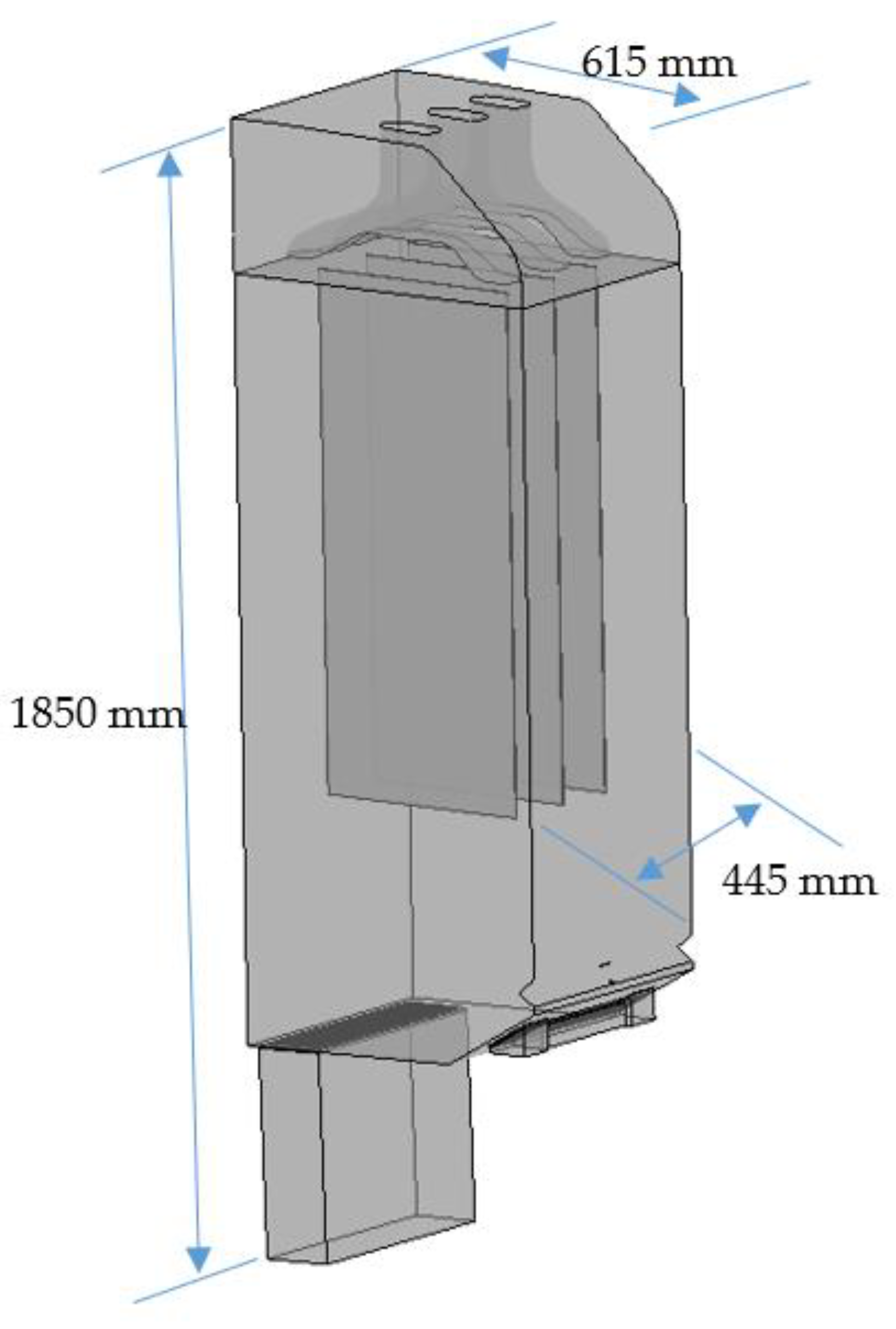
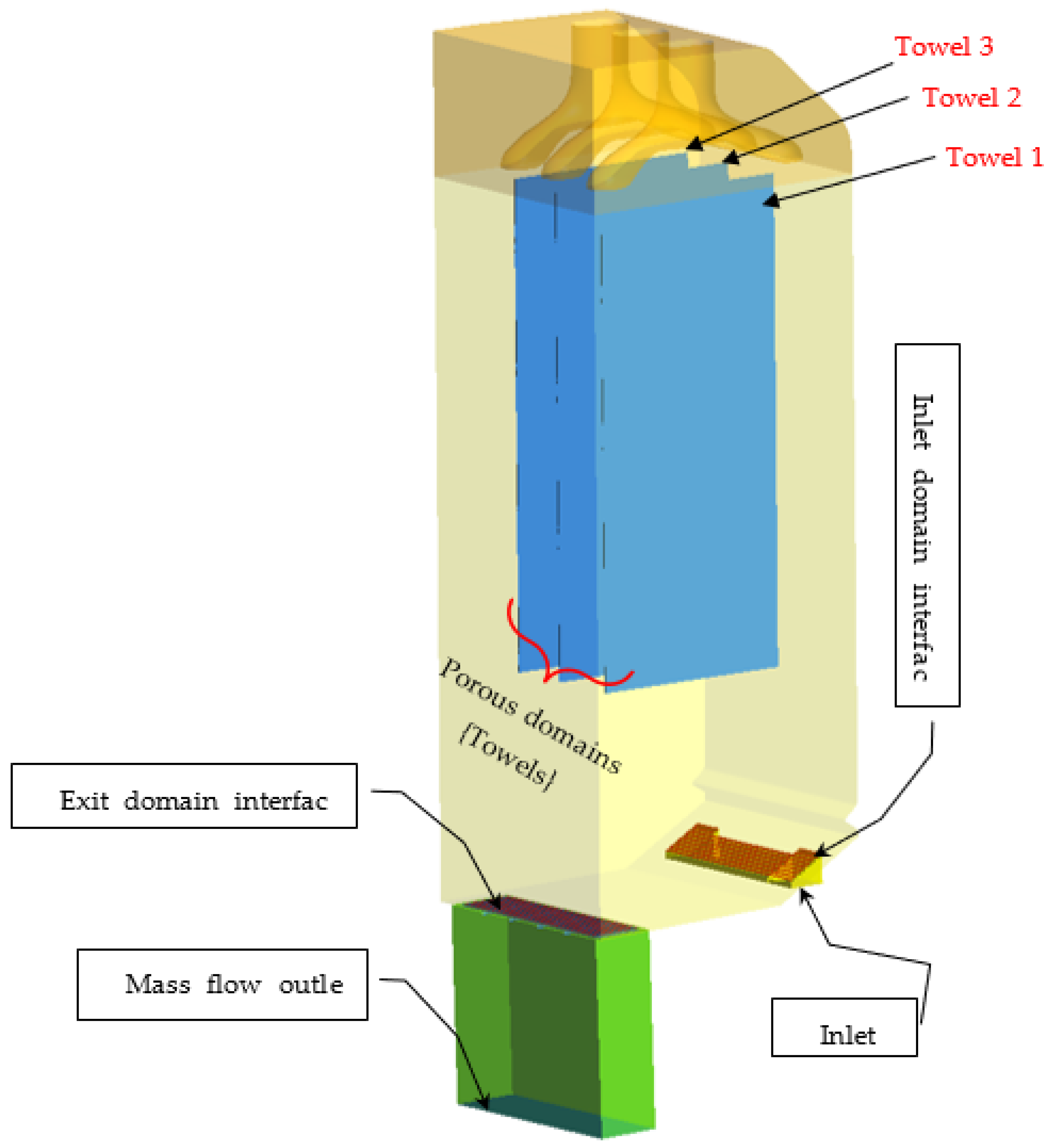
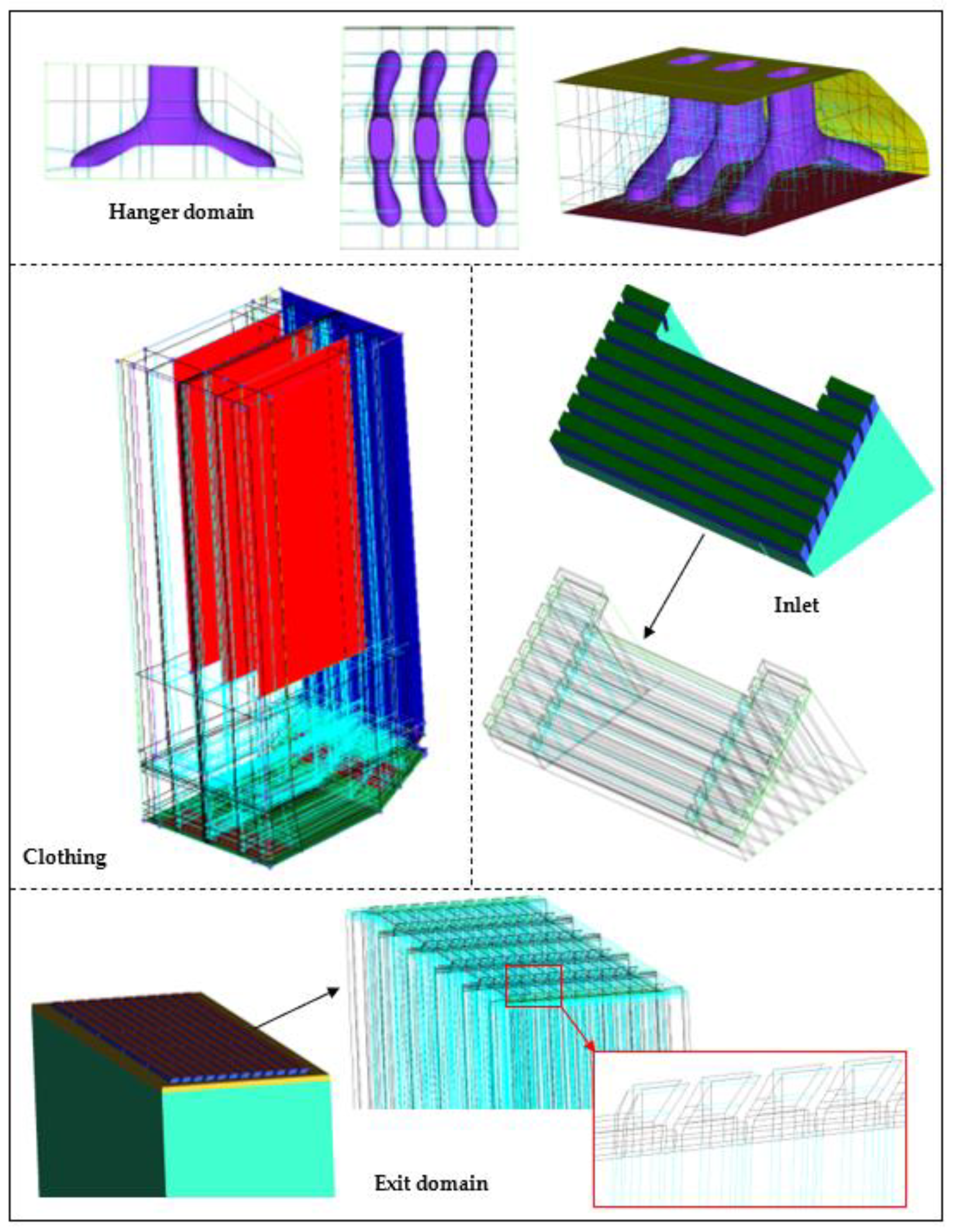
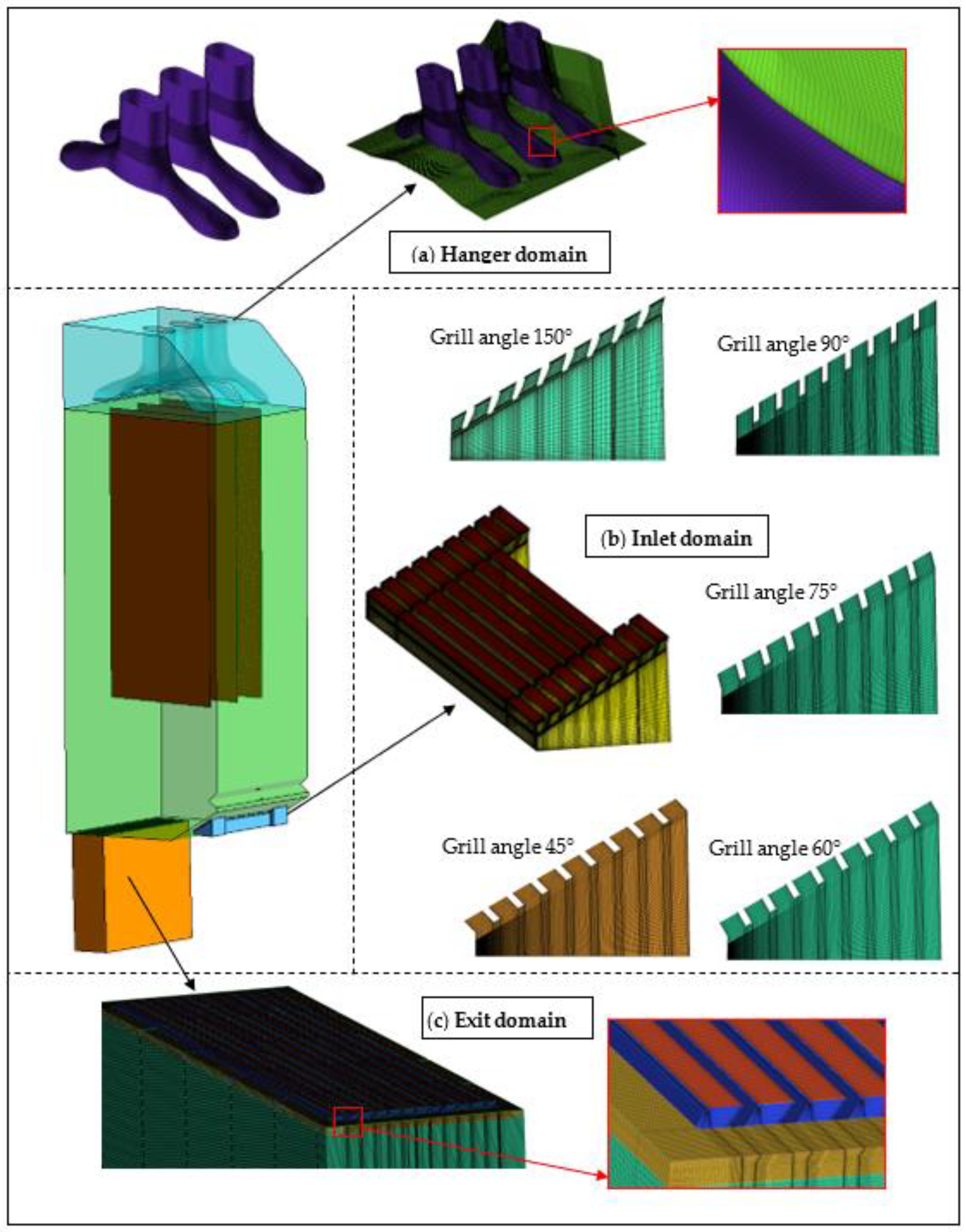
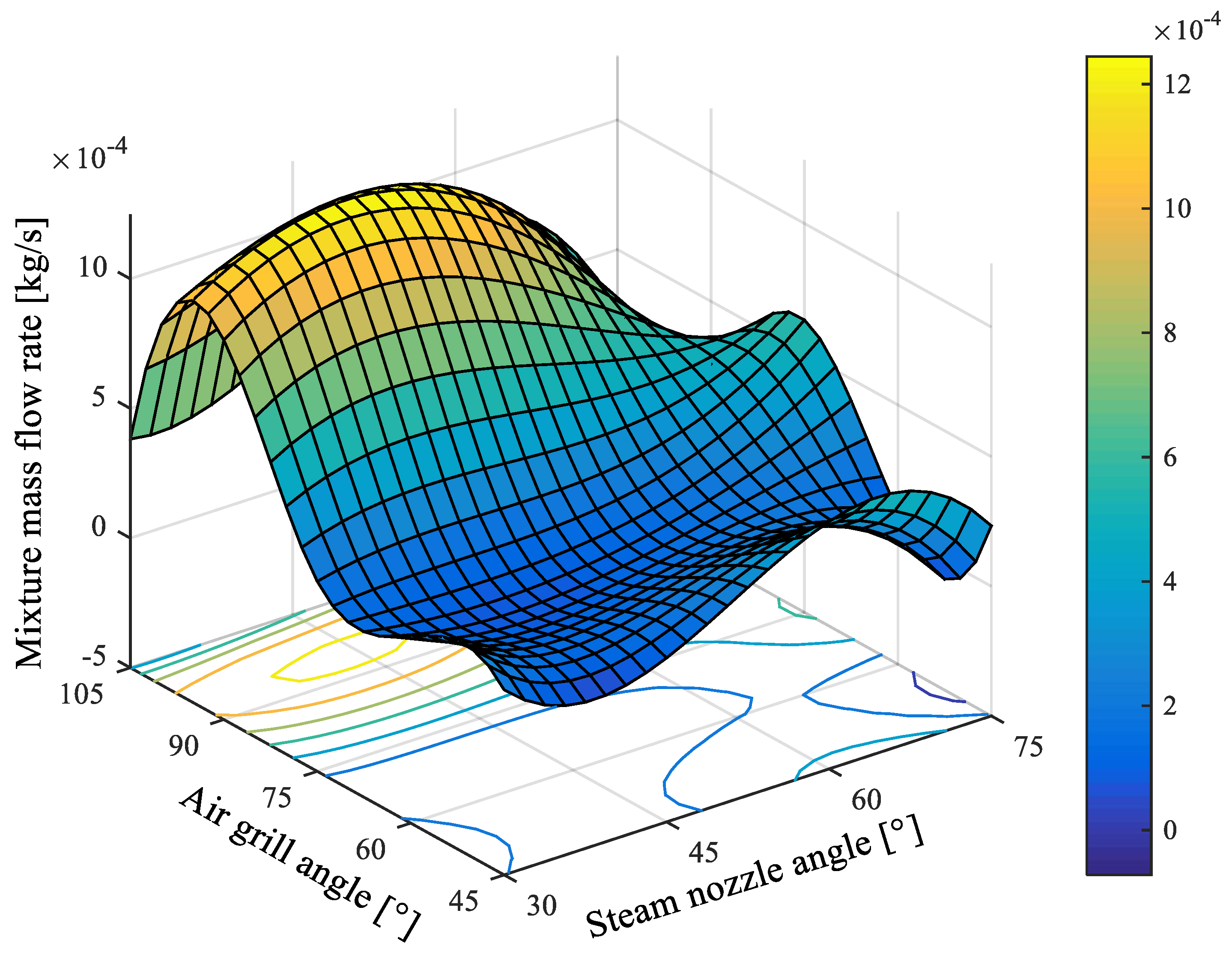
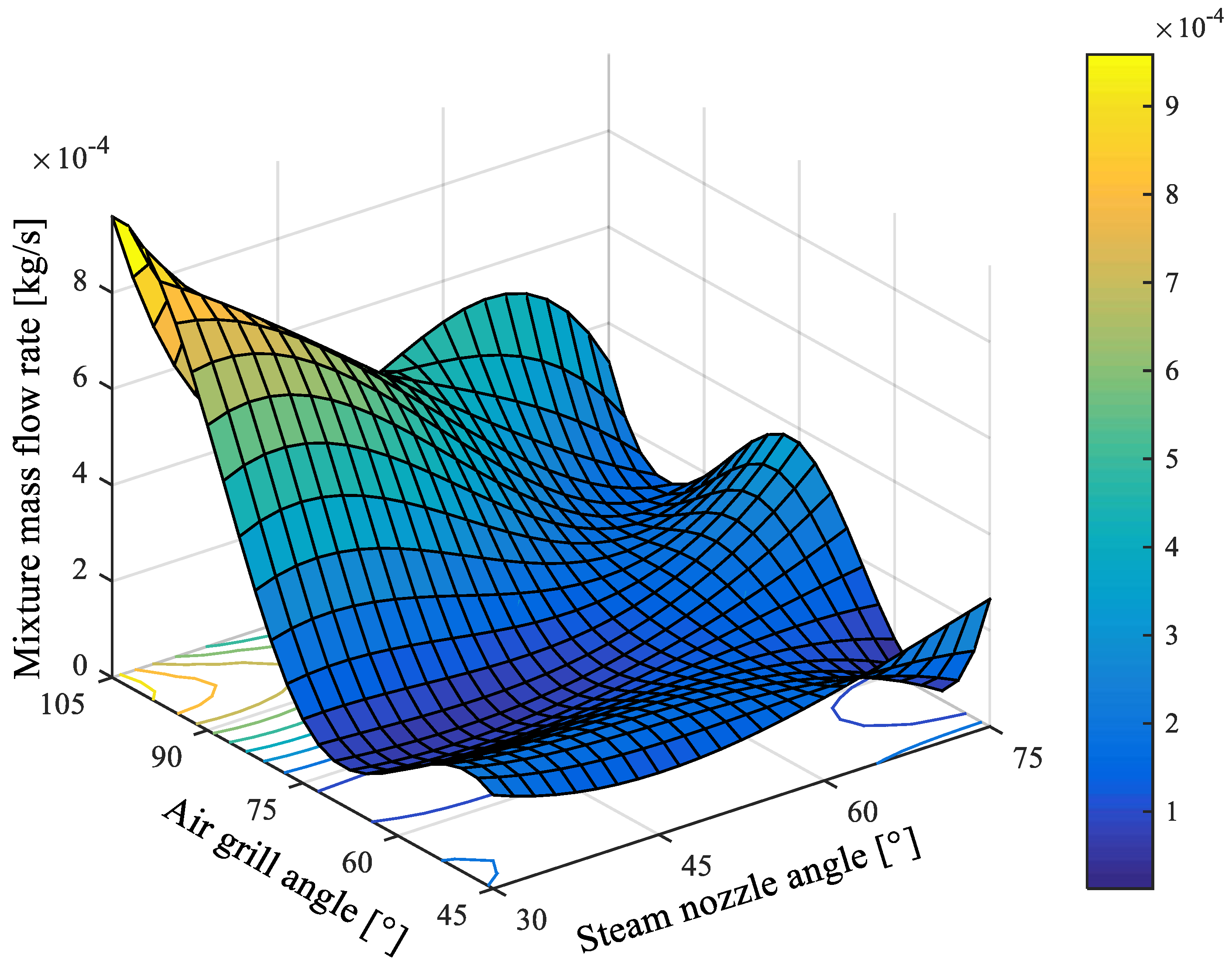

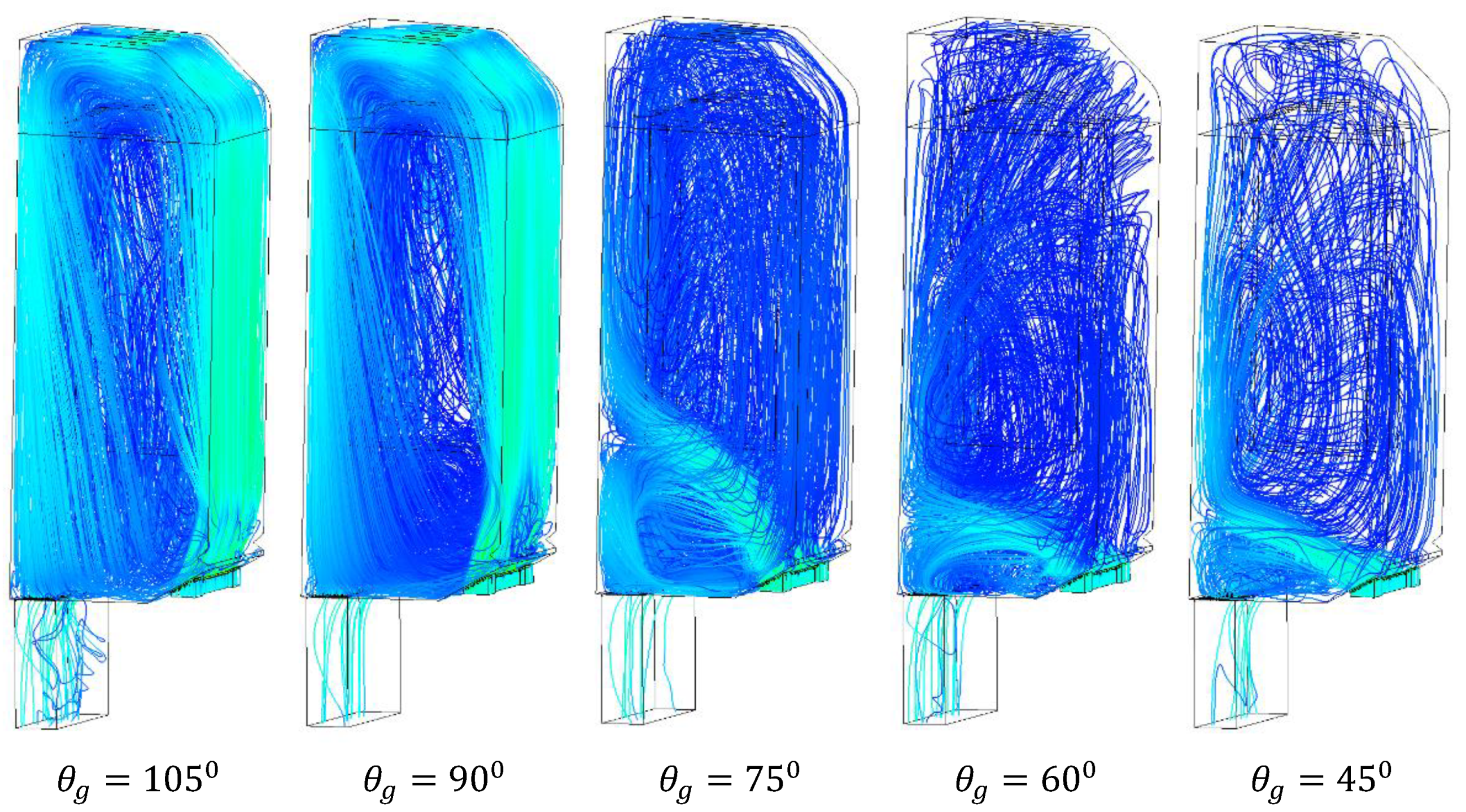

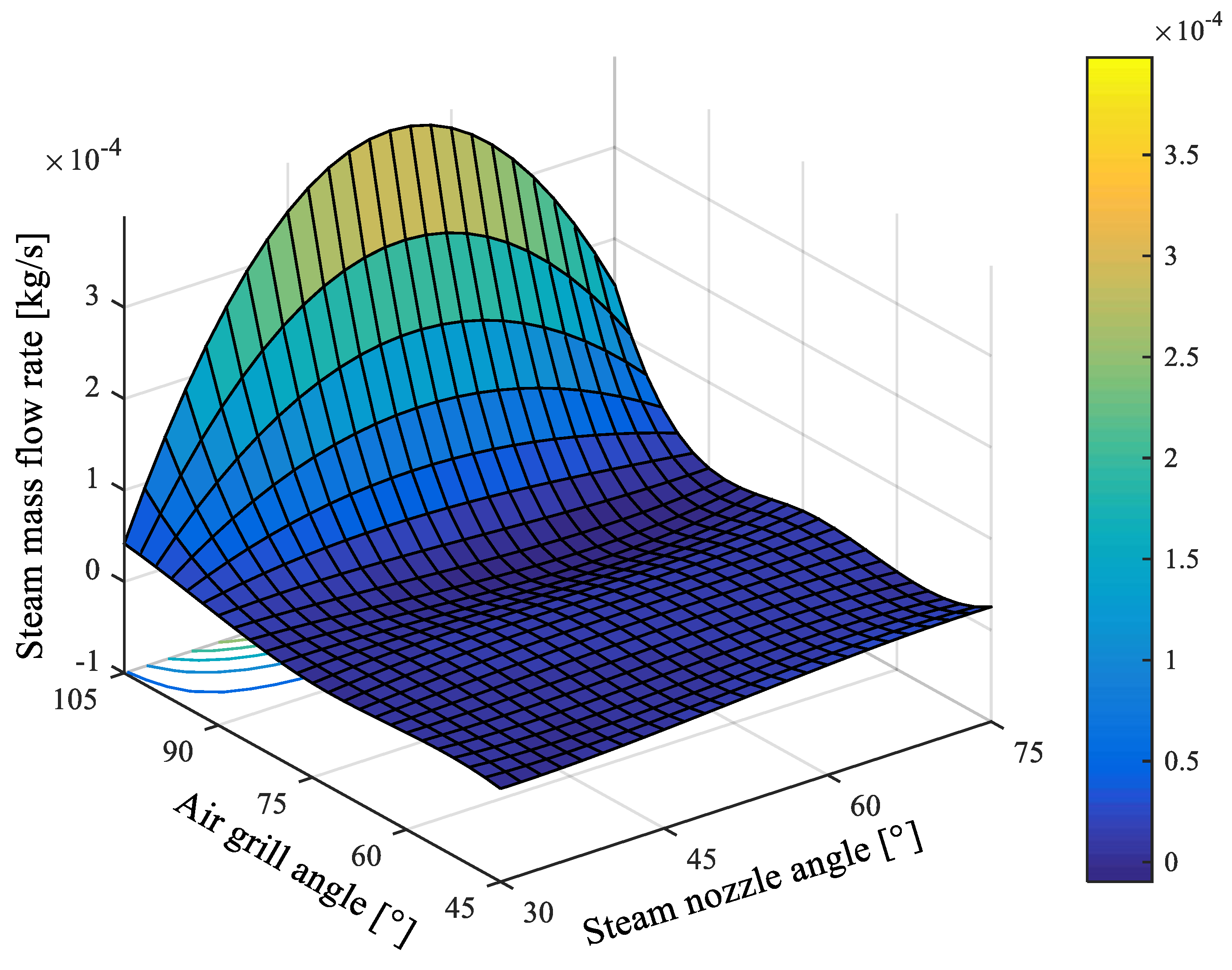

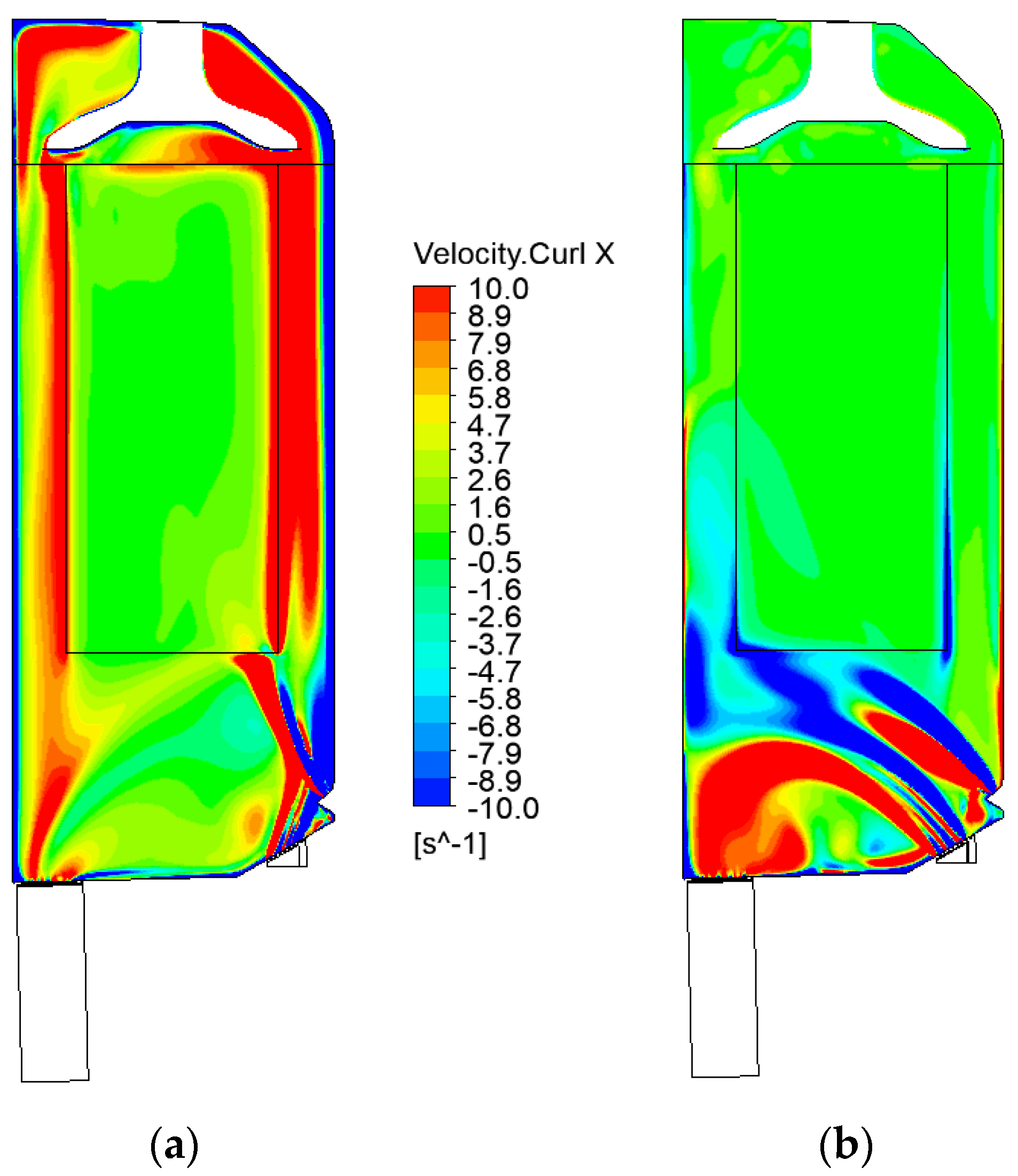
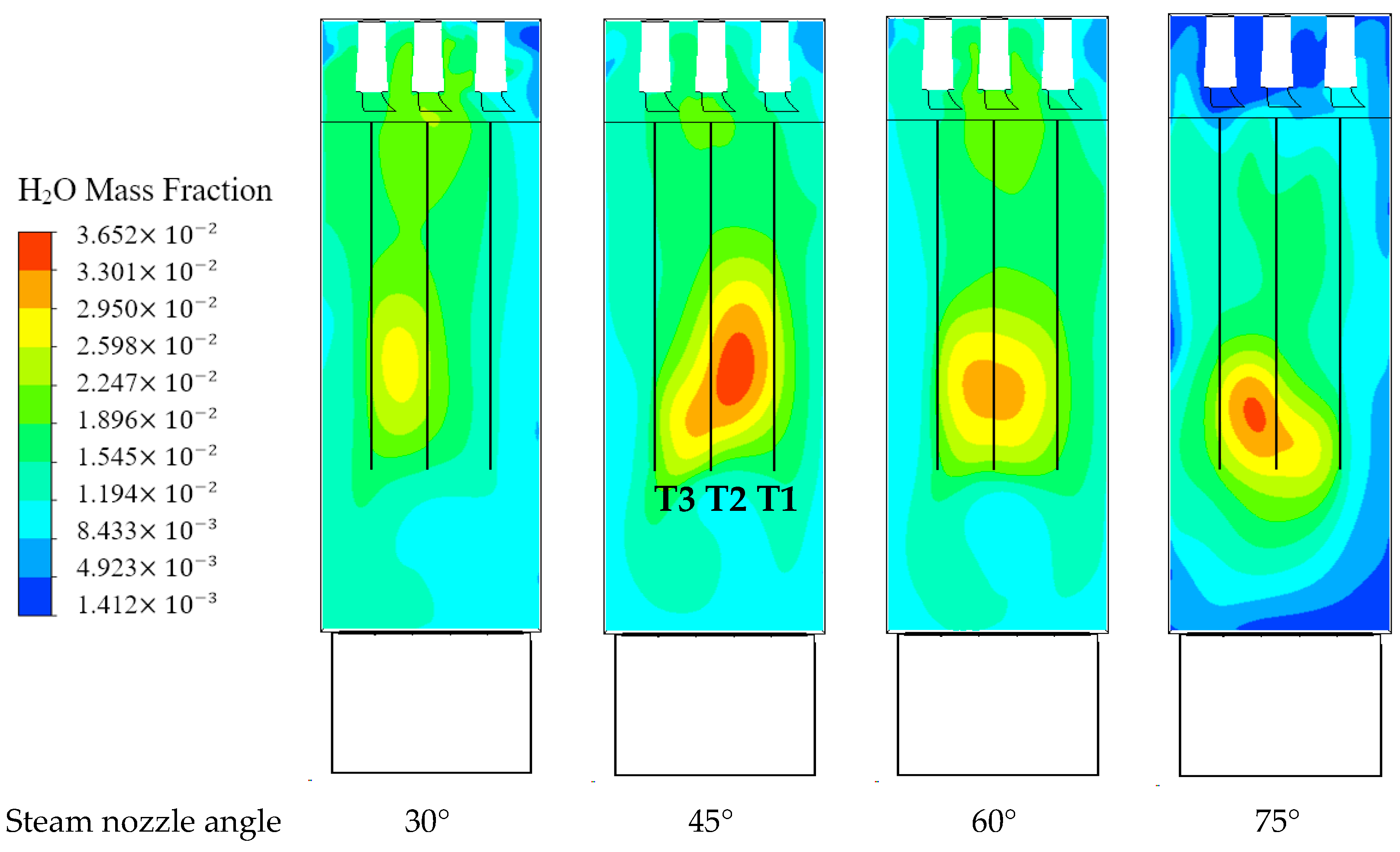
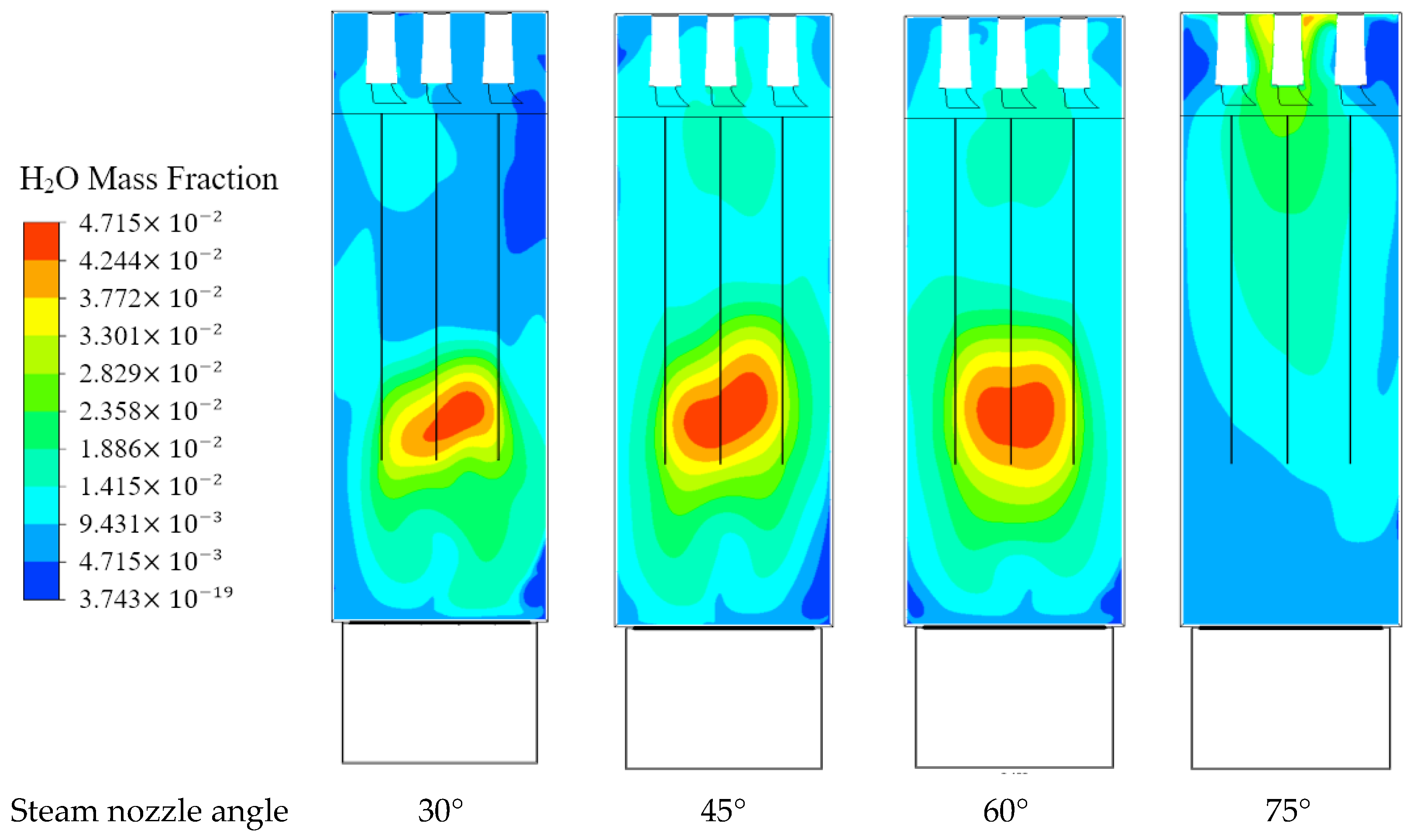
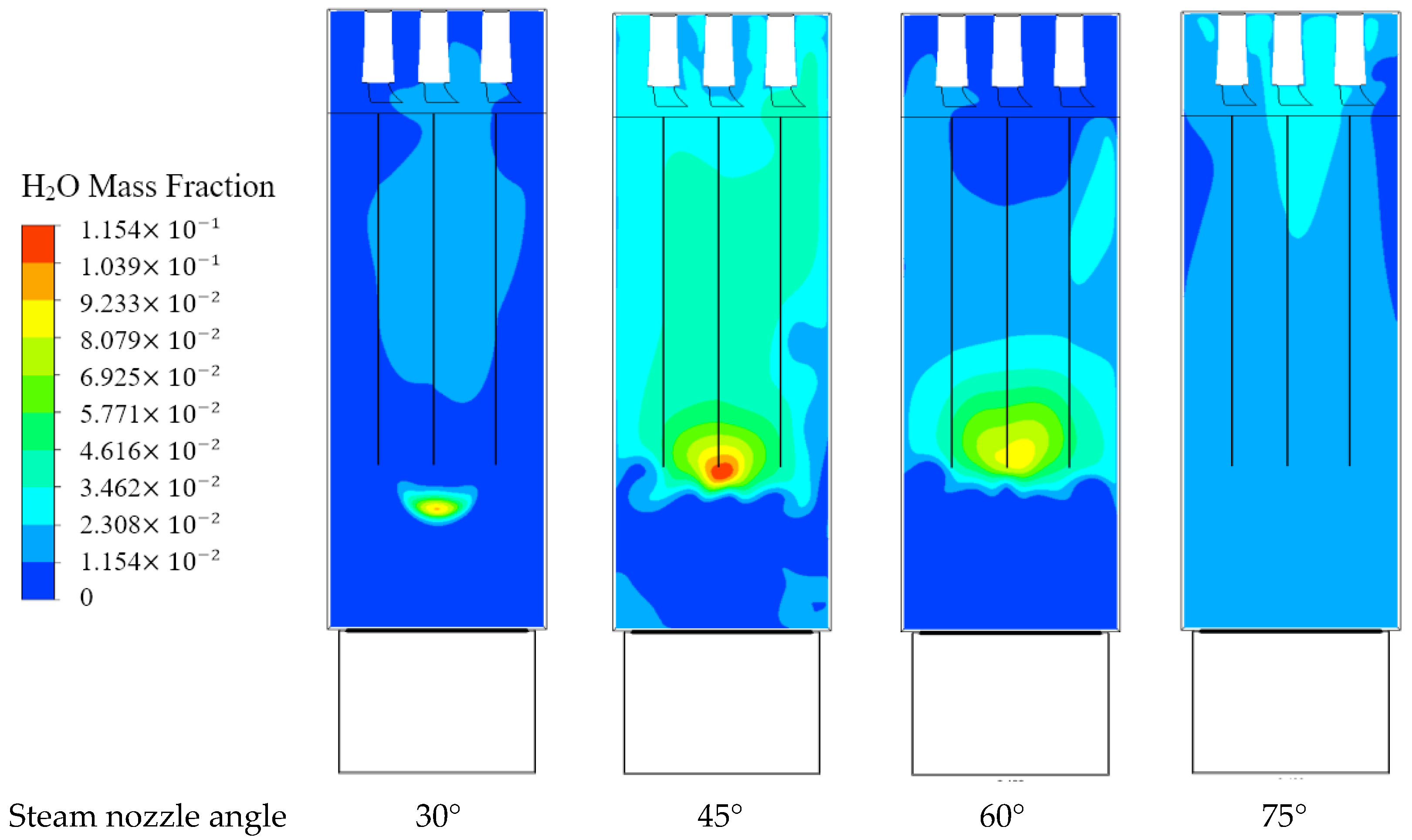
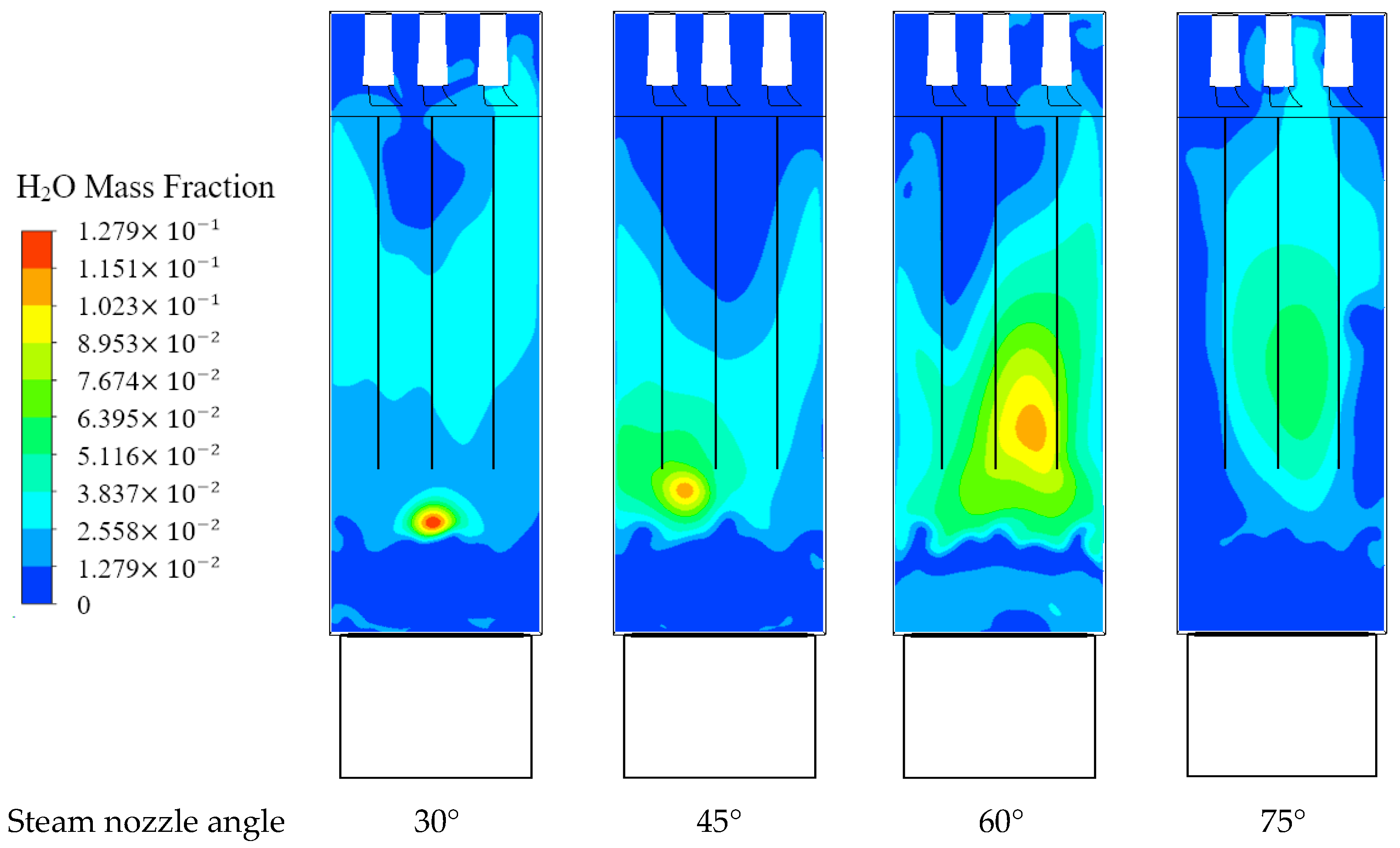

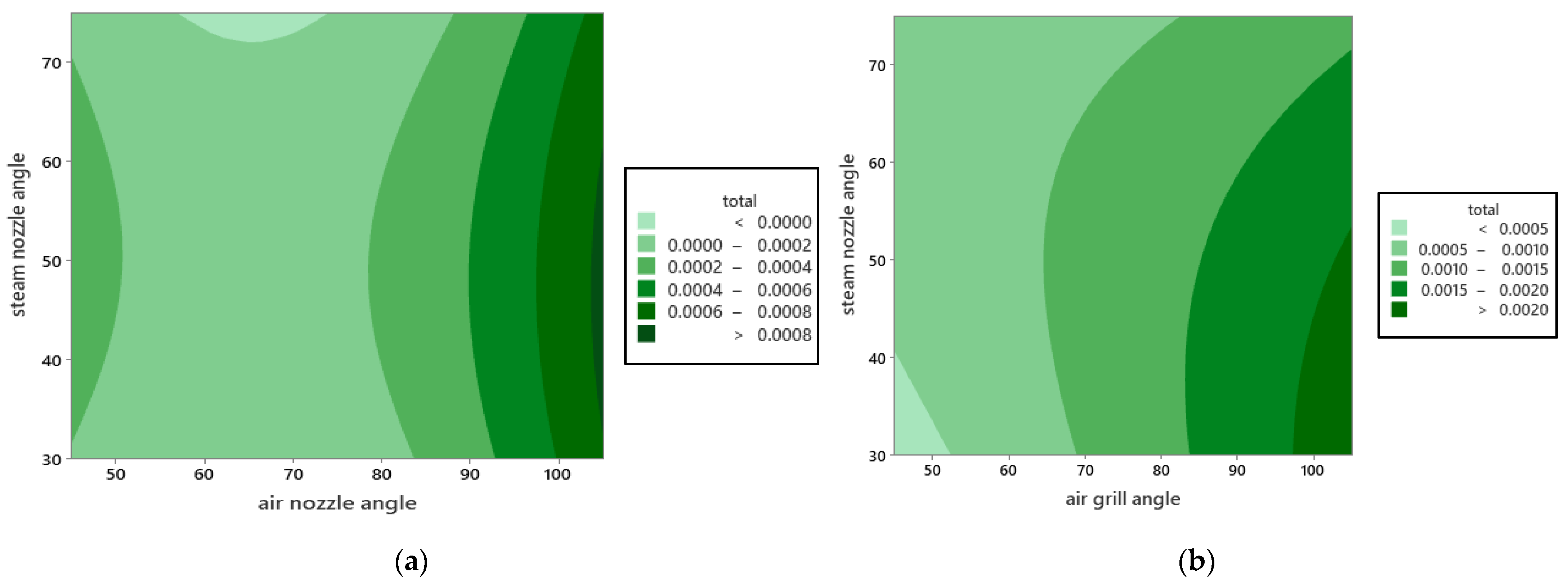
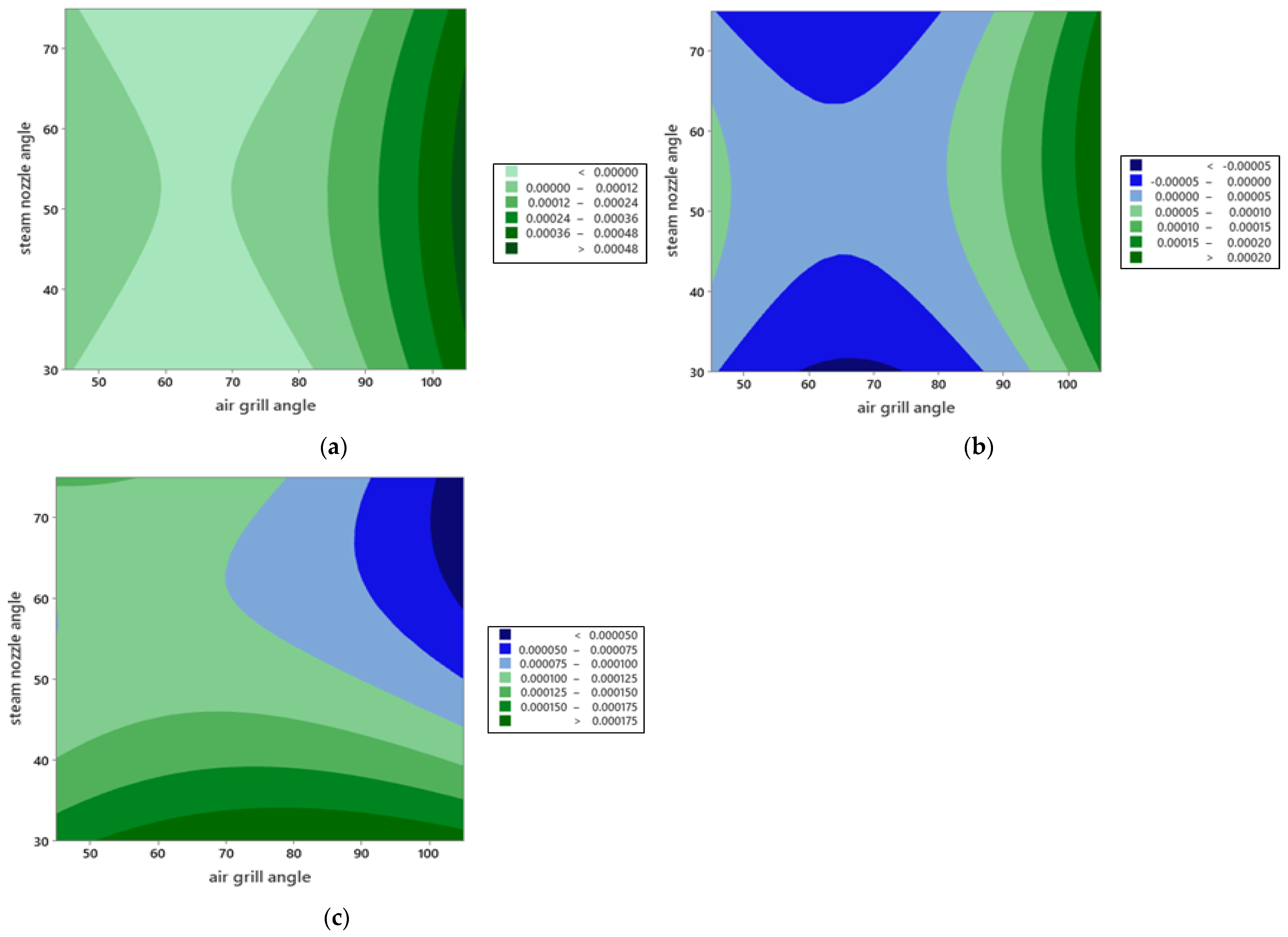
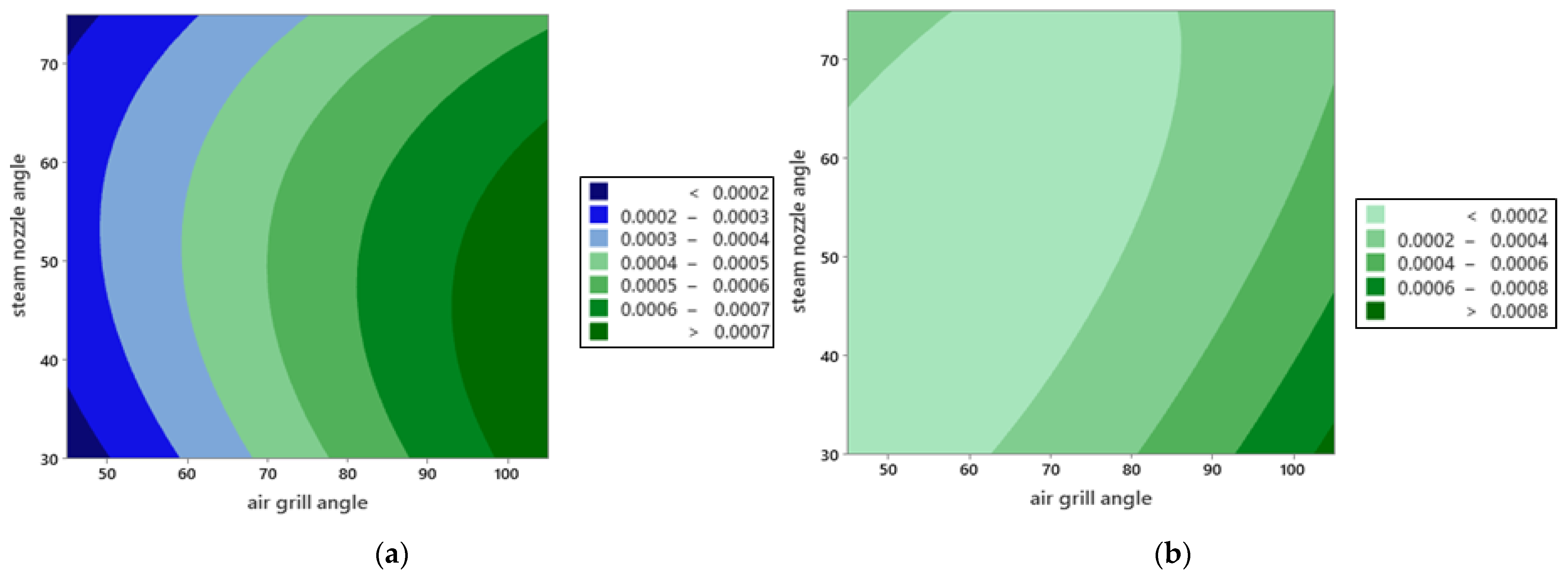


| Parameters | Operating Time, | Steam Amount Generated, | Air Flow Rate, | Incoming Air Temperature, | Grill Angle, | Nozzle Angle, |
|---|---|---|---|---|---|---|
| 400 | 275 | 1.35 | 320.15 | 45, 60, 75, 90, 105 | 30, 45, 60, 75 |
| Mesh Details | M1 | M2 | M3 | M4 | |
|---|---|---|---|---|---|
| Inlet domain | Number of nodes | 1,674,286 | 2,079,535 | 2,413,951 | 2,698,659 |
| Number of elements | 1,587,354 | 1,952,846 | 2,291,598 | 2,581,645 | |
| Exit domain | Number of nodes | 2,822,658 | 3,591,685 | 4,150,489 | 4,682,458 |
| Number of elements | 2,718,647 | 3,485,715 | 3,992,063 | 4,526,927 | |
| Clothing chamber | Number of nodes | 5,809,329 | 7,724,954 | 9,387,249 | 10,548,000 |
| Number of elements | 5,642,351 | 7,532,178 | 9,182,484 | 10,912,683 | |
| Hangers domain | Number of nodes | 1,834,712 | 2,336,519 | 2,855,908 | 3,358,241 |
| Number of elements | 1,765,945 | 2,248,758 | 2,773,827 | 3,264,584 | |
| Towels domain | Number of nodes | 85,274 | 118,453 | 172,500 | 296,755 |
| Number of elements | 72,648 | 102,869 | 135,432 | 285,621 | |
| CCU | Total nodes | 12,226,259 | 15,851,146 | 18,980,097 | 21,584,113 |
| Total elements | 11,786,945 | 15,322,366 | 18,375,404 | 21,571,460 | |
| S. No. | Flow Rate of Steam | Mixture Flow Rate | Air Grill Angle | Steam Nozzle Angle | S. No. | Flow Rate of Steam | Mixture Flow Rate | Air Grill Angle | Steam Nozzle Angle |
|---|---|---|---|---|---|---|---|---|---|
| 50.00 | −0.84 | −2.16 | 105.00 | 44.23 | 25.00 | −0.85 | −2.15 | 105.00 | 45.14 |
| 49.00 | −0.81 | −2.27 | 105.00 | 35.12 | 24.00 | −0.82 | −2.25 | 105.00 | 36.69 |
| 48.00 | −0.80 | −2.28 | 105.00 | 32.72 | 23.00 | −0.85 | −2.14 | 105.00 | 45.69 |
| 47.00 | −0.85 | −2.12 | 105.00 | 46.77 | 22.00 | −0.84 | −2.16 | 105.00 | 44.35 |
| 46.00 | −0.84 | −2.18 | 105.00 | 43.00 | 21.00 | −0.85 | −2.13 | 105.00 | 46.09 |
| 45.00 | −0.82 | −2.25 | 105.00 | 36.38 | 20.00 | −0.81 | −2.28 | 105.00 | 33.74 |
| 44.00 | −0.84 | −2.20 | 105.00 | 41.22 | 19.00 | −0.85 | −2.14 | 105.00 | 45.39 |
| 43.00 | −0.83 | −2.24 | 105.00 | 38.19 | 18.00 | −0.84 | −2.15 | 105.00 | 44.68 |
| 42.00 | −0.83 | −2.22 | 105.00 | 39.65 | 17.00 | −0.85 | −2.13 | 105.00 | 46.38 |
| 41.00 | −0.80 | −2.28 | 105.00 | 33.03 | 16.00 | −0.84 | −2.18 | 105.00 | 42.66 |
| 40.00 | −0.83 | −2.24 | 105.00 | 37.73 | 15.00 | −0.80 | −2.28 | 105.00 | 32.97 |
| 39.00 | −0.84 | −2.18 | 105.00 | 43.13 | 14.00 | −0.80 | −2.28 | 105.00 | 33.45 |
| 38.00 | −0.83 | −2.24 | 105.00 | 37.89 | 13.00 | −0.81 | −2.27 | 105.00 | 34.54 |
| 37.00 | −0.84 | −2.22 | 105.00 | 40.02 | 12.00 | −0.83 | −2.23 | 105.00 | 38.41 |
| 36.00 | −0.84 | −2.19 | 105.00 | 42.11 | 11.00 | −0.84 | −2.16 | 105.00 | 43.98 |
| 35.00 | −0.82 | −2.25 | 105.00 | 36.54 | 10.00 | −0.81 | −2.27 | 105.00 | 33.97 |
| 34.00 | −0.84 | −2.19 | 105.00 | 42.40 | 9.00 | −0.84 | −2.20 | 105.00 | 41.54 |
| 33.00 | −0.82 | −2.26 | 105.00 | 35.30 | 8.00 | −0.84 | −2.21 | 105.00 | 40.77 |
| 32.00 | −0.83 | −2.23 | 105.00 | 39.10 | 7.00 | −0.84 | −2.21 | 105.00 | 40.63 |
| 31.00 | −0.84 | −2.15 | 105.00 | 44.79 | 6.00 | −0.81 | −2.27 | 105.00 | 34.87 |
| 30.00 | −0.81 | −2.27 | 105.00 | 34.34 | 5.00 | −0.82 | −2.25 | 105.00 | 37.10 |
| 29.00 | −0.84 | −2.17 | 105.00 | 43.56 | 4.00 | −0.85 | −2.12 | 105.00 | 46.52 |
| 28.00 | −0.83 | −2.23 | 105.00 | 38.79 | 3.00 | −0.83 | −2.23 | 105.00 | 38.61 |
| 27.00 | −0.85 | −2.12 | 105.00 | 46.89 | 2.00 | −0.84 | −2.19 | 105.00 | 41.80 |
| 26.00 | −0.83 | −2.24 | 105.00 | 37.35 | 1.00 | −0.85 | −2.12 | 105.00 | 46.89 |
Publisher’s Note: MDPI stays neutral with regard to jurisdictional claims in published maps and institutional affiliations. |
© 2022 by the authors. Licensee MDPI, Basel, Switzerland. This article is an open access article distributed under the terms and conditions of the Creative Commons Attribution (CC BY) license (https://creativecommons.org/licenses/by/4.0/).
Share and Cite
Saleem, A.; Saeed, M.; Kim, M.-H. Optimisation of Induced Steam Residual Moisture Content in a Clothing Conditioner Based on a Genetic Algorithm. Energies 2022, 15, 5696. https://doi.org/10.3390/en15155696
Saleem A, Saeed M, Kim M-H. Optimisation of Induced Steam Residual Moisture Content in a Clothing Conditioner Based on a Genetic Algorithm. Energies. 2022; 15(15):5696. https://doi.org/10.3390/en15155696
Chicago/Turabian StyleSaleem, Arslan, Muhammad Saeed, and Man-Hoe Kim. 2022. "Optimisation of Induced Steam Residual Moisture Content in a Clothing Conditioner Based on a Genetic Algorithm" Energies 15, no. 15: 5696. https://doi.org/10.3390/en15155696
APA StyleSaleem, A., Saeed, M., & Kim, M.-H. (2022). Optimisation of Induced Steam Residual Moisture Content in a Clothing Conditioner Based on a Genetic Algorithm. Energies, 15(15), 5696. https://doi.org/10.3390/en15155696








